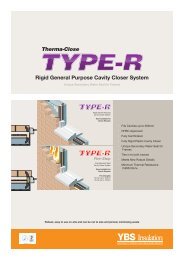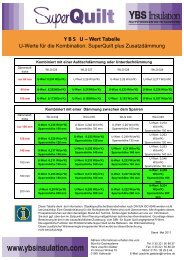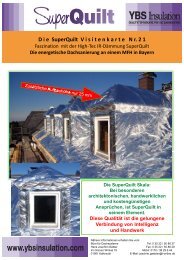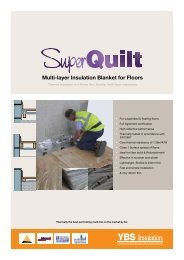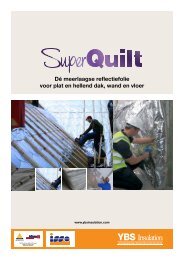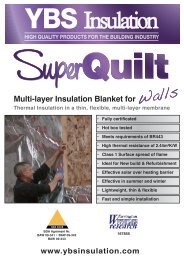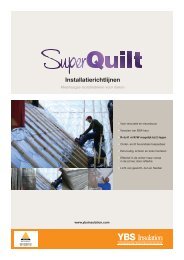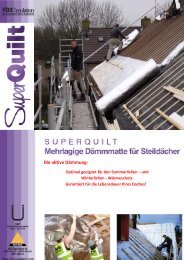YBS 232 Superfloor Data Sheet:Layout 2 - YBS Insulation
YBS 232 Superfloor Data Sheet:Layout 2 - YBS Insulation
YBS 232 Superfloor Data Sheet:Layout 2 - YBS Insulation
Create successful ePaper yourself
Turn your PDF publications into a flip-book with our unique Google optimized e-Paper software.
SuperFloor Foil-Tec <strong>Insulation</strong><br />
Foil-Tec Single for Solid Ground Floors<br />
ACHIEVES A<br />
THERMAL<br />
OUTPUT OF<br />
85 WATTS/M 2<br />
• <strong>Superfloor</strong> Single is rolled out onto concrete floor with shiny<br />
side facing upwards - leaving enough edge overlap for 75mm<br />
lip to be left behind skirting.<br />
• Timber battens/joists (min 50mm x 50mm) are then laid on<br />
top of the <strong>Superfloor</strong> single, spaced at centres to suit the<br />
particular flooring.<br />
• The decking is then fixed with screws (at 200mm centres) into<br />
battens/joists providing 25mm penetration into the 50mm<br />
wide battens/joists.<br />
<strong>Superfloor</strong> Foil-Tec for solid ground floors has a thermal output<br />
of 85W/m 2 as tested by BSRIA.<br />
SuperFloor Board<br />
SuperFloor Board for Solid Ground Floors<br />
Floor Applications<br />
The screeded system comprises:<br />
• The <strong>Superfloor</strong> edge strip - to be laid against all external and<br />
internal walls, providing edge insulation and an expansion<br />
zone for the screed.<br />
• <strong>Superfloor</strong> insulation board is laid on top of the concrete slab.<br />
(<strong>YBS</strong> provide a wide range of thicknesses and types of<br />
insulation to ensure the required insulating properties are<br />
achieved).<br />
• Using the grid pattern - lay down the heating pipes as<br />
planned, using the specially designed <strong>YBS</strong> fixing clips to fix<br />
position.<br />
• The screed is standard with no special additives.<br />
• Most situations will require 65-85mm thickness of screed.<br />
• Reinforcing mesh can be used where required.<br />
• Expansion profiles are to be used where pipework passes<br />
through an expansion.<br />
FLOORING U-VALUES<br />
Perimeter Length to Area Ratio U-Value W/m2K<br />
1:1 0.46<br />
0:9 0.45<br />
0:8 0.44<br />
0:7 0.42<br />
0:6 0.4<br />
0:5 0.38<br />
0:4 0.35<br />
0:3 0.3<br />
0:2 0.26<br />
0:1 0.17<br />
Floor Covering<br />
65mm Screed<br />
/Concrete<br />
SuperFloor<br />
Insulated Edge Strip<br />
Pipe Clips<br />
Heating Pipes<br />
SuperFloor<br />
<strong>Insulation</strong> Board<br />
DPM<br />
<strong>Superfloor</strong> <strong>Insulation</strong> is available with Expanded Polystyrene, Extruded Polystyrene or Polyurethane<br />
EXPANDED POLYSTYRENE<br />
EPS SILVER<br />
EXTRUDED POLYSTYRENE<br />
POLYURETHANE<br />
If budget is tight then standard<br />
Expanded Polystyrene is a<br />
very cost effective answer. It’s<br />
thermal conductivity for EPS<br />
70 is 0.038W/Mk and EPS 100<br />
is 0.036W/Mk.<br />
A cost effective interim board,<br />
is EPS Silver with an improved<br />
thermal conductivity (similar to<br />
Extruded Polystyrene)<br />
0.030W/Mk.<br />
Extruded Polystyrene can be<br />
employed in areas where the<br />
design load is critical - often in<br />
factory and commercial situations.<br />
Its thermal conductivity<br />
is 0.029W/Mk.<br />
If floor height is absolutely<br />
critical then the most effective<br />
insulation, polyurethane, twice<br />
as efficient as Polystyrene, offers<br />
the best solution. Its thermal<br />
conductivity is 0.023W/Mk.



